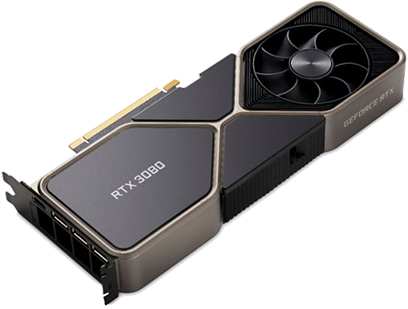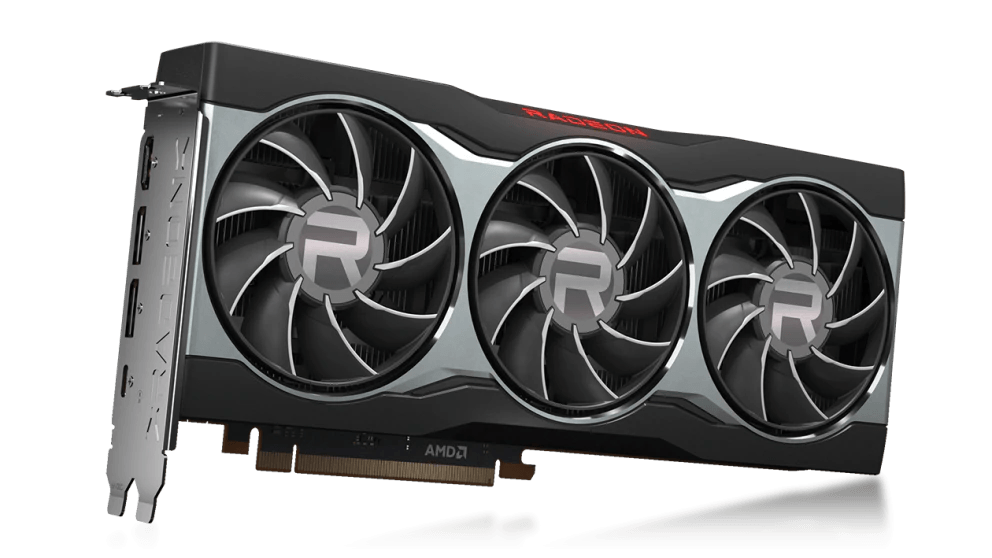NVIDIA’s Flagship
NVIDIA GeForce RTX 3080
Less Power, Less Price
AMD Radeon RX 6800
NVIDIA’s flagship RTX 3080 is the graphics card to buy if you primarily want to game at a 4K resolution for this generation and next generation. Its ray tracing capabilities outpace those of the RX 6800, and DLSS is, so far, an unmatched feature that boosts framerates in compatible games. It costs more than the RX 6800 (about $120 more at list price), but it’s well worth it if you need the extra performance.
Pros
- Mature ray tracing capabilities
- DLSS helps performance
- Power for high-end 4K
- HDMI 2.1, AV1 decode
- NVIDIA Broadcast stands out
Cons
- Costs more than RX 6800
- Very hard to find
- Overkill for many people
AMD’s RX 6800 is a powerful graphics card that’s best directed at a top-tier 1440p gaming experience. It is capable of ray tracing, though it doesn’t measure up to NVIDIA RTX. It’s also, so far, lacking a DLSS equivalent and suffers from many of the same availability issues. If you need a GPU for 1440p and want to spend significantly less money (at list price), this is the card for you.
Pros
- Potent 1440p performance
- Capable of entry-level 4K
- HDMI 2.1, AV1 decode
- Cheaper than RTX 3080
- Less power consumption
Cons
- No DLSS equivalent
- Ray tracing not as mature
- Limited availability
NVIDIA’s GeForce RTX 3080 and AMD’s Radeon RX 6800 are both included in our best graphics card roundup, and for good reason. They’re both powerful GPUs that will make modern games look gorgeous. However, the RTX 3080 is much better used for 4K while the RX 6800 is much better cut out for 1440p (what many call 2K). There are plenty more differences between these two GPUs, which I’ll lay out starting with some raw specs.
NVIDIA RTX 3080 vs. AMD RX 6800 tech specs
| NVIDIA RTX 3080 | AMD RX 6800 | |
|---|---|---|
| Architecture | Ampere | RDNA 2 |
| Shader/Stream | 8,704 | 3,840 |
| Tensor/Texture | 272 | 240 |
| Clock | 1,440MHz | 1,700MHz |
| Boost clock | 1,710MHz | 2,105MHz |
| Memory | 10GB GDDR6X | 16GB GDDR6 |
| Bus width | 320-bit | 256-bit |
| Transistors | 28.3 billion | 26.8 billion |
| Node | 8nm | 7nm |
| TDP | 320W | 250W |
| Recommended PSU | 750W | 650W |
| Slot size | Two | Two |
NVIDIA RTX 3080 vs. AMD RX 6800: Performance and features

NVIDIA’s GeForce RTX 3080 is an Ampere-powered GPU that’s currently the best option out there for 4K gaming. It offers enormous gains over RTX 20-series cards thanks to streaming multiprocessors with twice as much throughput, second-generation ray tracing cores with far better performance, and third-gen Tensor cores for advanced AI accompaniment with features like Deep Learning Super Sampling (DLSS) and NVIDIA Broadcast. Our guide on ray tracing and DLSS has a closer look at the two technologies.
RDNA 2 GPUs, including the AMD Radeon RX 6800, bring their own ray tracing capabilities to the table. You can enjoy ray tracing in compatible games with the RX 6800, but it delivers a far heavier blow to performance compared to NVIDIA’s hardware. In many cases, NVIDIA DLSS is also standing by to reduce the ray-tracing performance hit. AMD does have an answer to NVIDIA’s super sampling technology, called FidelityFX Super Resolution, but it’s still under development. Bottom line? As it stands now, if you’re excited about ray tracing, stick with NVIDIA.

Another big feature available only with NVIDIA cards is NVIDIA Broadcast. It employs AI enhancements for voice and video, making live streams, chats, and video calls that much better. It will remove ambient and background noise, it can remove or change a video’s background, and it can track movement in a video. It works incredibly well and is an enormous boon for streamers and professionals who spend considerable time conferencing.
AMD isn’t without some interesting features. Although Rage Mode overclocking isn’t available with the non-XT variants of RX 6000-series GPUs, the RX 6800 can still benefit from Smart Access Memory (SAM) and Infinity Cache. SAM is essentially a fancy name for resizable Base Address Register (BAR) support, which can boost performance in plenty of games as long as you’re using an RX 6000-series GPU and Ryzen 3000 or Ryzen 5000 desktop processor. I benchmarked AMD Smart Access Memory at 1440p and 4K to see just how much of a difference it makes. It can make a significant difference in many games, but not all games. And since it’s not a proprietary technology, NVIDIA could do something similar.

The RTX 3080 is best suited for 4K gaming, while the RX 6800 will crush 1440p.
Infinity Cache is maybe the most impressive feature of the new RDNA 2 cards. Instead of widening the memory bus, AMD stuck with 256-bit and added a 128MB L3 cache with significant density for improved efficiency. With bandwidth upped, there’s about 34% less memory latency between RDNA and RDNA 2 technologies.
However, what really matters to most people is raw performance and what the GPUs are capable of in real-world scenarios. To put it simply, the RTX 3080 should be the GPU you choose for 4K gaming. The RX 6800 should be the GPU you choose from 1440p gaming.
That doesn’t mean the cards can’t cross resolutions. For example, the RTX 3080 will trounce the RX 6800 at 1440p, but its elevated cost and power draw make it less ideal. That doesn’t mean you can’t buy the RTX 3080 for 1440p, since all those extra frames will make a difference. If you’re a competitive gamer, boosting FPS by, say, 60FPS in esports titles at 1440p with the RTX 3080 will make sense. The per-game boost will differ significantly, but you can expect as a rule better performance at all resolutions with the RTX 3080.

On the other side, the RX 6800 can handle 4K and will power many games up to or above the 60FPS mark, but it won’t fare nearly as well as the RTX 3080. If you’re aiming primarily at 4K, the RTX 3080’s extra cost will be well worth it. The RX 6800 is intended for 1440p where it truly excels. Even in some of the most demanding games currently available (think Metro Exodus, Red Dead Redemption 2), it will still push well above 60FPS with in-game settings turned all the way up. If you have a QHD monitor with a high refresh rate, the RX 6800 will get a lot out of it.
Keep in mind that the RTX 3080 has a significantly higher TDP at 320W compared to the RX 6800’s 250W. NVIDIA recommends a 750W PSU for the RTX 3080, while AMD recommends a 650W PSU for the RX 6800. If you’re looking at a build with more modest power consumption, the RX 6800 should be a more attractive choice. Be sure to have a look at our guides for best PSU for NVIDIA RTX 3080 and best PSU for AMD RX 6800 if you need some new hardware.
NVIDIA’s RTX 3080 is the GPU for 4K gaming
Want to invest in a GPU that can easily handle 4K? Want more mature ray tracing capabilities and DLSS to back it up? Think NVIDIA Broadcast is an unmissable feature? The RTX 3080 should be your first choice, but it is going to cost more than the RX 6800. There’s also the matter of unavailability, but that’s an issue that doesn’t discriminate between NVIDIA and AMD. Have a look at our guide on where to buy NVIDIA RTX 30-series GPUs for more information.
NVIDIA’s Flagship
NVIDIA GeForce RTX 3080
Best for 4K gaming
NVIDIA’s RTX 3080 delivers better ray tracing, DLSS advancements, and the power for smooth 4K gaming at elevated framerates.
AMD’s RX 6800 is the better GPU for 1440p
AMD’s Radeon RX 6800 is a more affordable alternative to the RTX 3080 that draws less power but doesn’t put out as much raw performance. It’s best suited for a strong 1440p gaming experience. The RX 6800 is just as hard to buy as the RTX 3080, but check out our guide on where to buy AMD Radeon RX 6000 GPUs for a bit of help.
Less Power, Less Price
AMD Radeon RX 6800
Best for 1440p gaming
Don’t care as much about ray tracing or DLSS and just want a more affordable GPU capable of delivering top-tier 1440p gaming? The RX 6800 is the card for you.
We may earn a commission for purchases using our links. Learn more.








